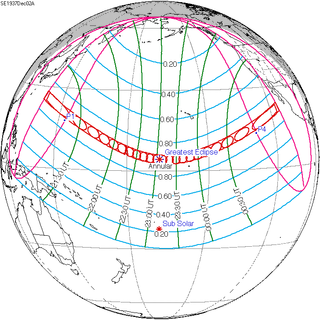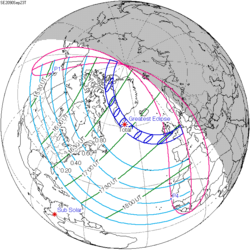Top Qs
Timeline
Chat
Perspective
Solar eclipse of December 2, 1937
20th-century annular solar eclipse From Wikipedia, the free encyclopedia
Remove ads
An annular solar eclipse occurred at the Moon's ascending node of orbit between Thursday, December 2 and Friday, December 3, 1937,[1] with a magnitude of 0.9184. A solar eclipse occurs when the Moon passes between Earth and the Sun, thereby totally or partly obscuring the image of the Sun for a viewer on Earth. An annular solar eclipse occurs when the Moon's apparent diameter is smaller than the Sun's, blocking most of the Sun's light and causing the Sun to look like an annulus (ring). An annular eclipse appears as a partial eclipse over a region of the Earth thousands of kilometres wide. Occurring about 18 hours before apogee (on December 3, 1937, at 16:50 UTC), the Moon's apparent diameter was smaller.[2]
The duration of annularity at maximum eclipse (closest to but slightly shorter than the longest duration) was 12 minutes, 0.33 seconds in the Pacific Ocean. It was the longest annular solar eclipse since December 25, 1628, but the Solar eclipse of December 14, 1955 lasted longer.[3]
Annularity was visible from outlying islands in Japan on December 3, including part of Ogasawara Village and South Seas Mandate (the part now belonging to Marshall Islands), and also Teraina and Tabuaeran in the Gilbert and Ellice Islands (the part now belonging to Kiribati), a colony of the United Kingdom, on December 2. (However, time zone of the Line Islands including Teraina and Tabuaeran was changed from UTC−10 to UTC+14 in 1995. The date would be December 3 for all annular eclipse visible from land if observing the present day's time zone.)
A partial eclipse was visible for parts of East Asia, northern Oceania, Hawaii, and western North America. Part of these areas are east of the 180th meridian, seeing the eclipse on December 2, and the rest west of the 180th meridian, seeing the eclipse on December 3.
Remove ads
Eclipse details
Summarize
Perspective
Shown below are two tables displaying details about this particular solar eclipse. The first table outlines times at which the Moon's penumbra or umbra attains the specific parameter, and the second table describes various other parameters pertaining to this eclipse.[4]
Remove ads
Eclipse season
This eclipse is part of an eclipse season, a period, roughly every six months, when eclipses occur. Only two (or occasionally three) eclipse seasons occur each year, and each season lasts about 35 days and repeats just short of six months (173 days) later; thus two full eclipse seasons always occur each year. Either two or three eclipses happen each eclipse season. In the sequence below, each eclipse is separated by a fortnight.
Remove ads
Related eclipses
Eclipses in 1937
- A penumbral lunar eclipse on May 25.
- A total solar eclipse on June 8.
- A partial lunar eclipse on November 18.
- An annular solar eclipse on December 2.
Metonic
- Preceded by: Solar eclipse of February 14, 1934
- Followed by: Solar eclipse of September 21, 1941
Tzolkinex
- Preceded by: Solar eclipse of October 21, 1930
- Followed by: Solar eclipse of January 14, 1945
Half-Saros
- Preceded by: Lunar eclipse of November 27, 1928
- Followed by: Lunar eclipse of December 8, 1946
Tritos
- Preceded by: Solar eclipse of January 3, 1927
- Followed by: Solar eclipse of November 1, 1948
Solar Saros 141
- Preceded by: Solar eclipse of November 22, 1919
- Followed by: Solar eclipse of December 14, 1955
Inex
- Preceded by: Solar eclipse of December 23, 1908
- Followed by: Solar eclipse of November 12, 1966
Triad
- Preceded by: Solar eclipse of February 1, 1851
- Followed by: Solar eclipse of October 2, 2024
Solar eclipses of 1935–1938
This eclipse is a member of a semester series. An eclipse in a semester series of solar eclipses repeats approximately every 177 days and 4 hours (a semester) at alternating nodes of the Moon's orbit.[5]
The partial solar eclipses on February 3, 1935 and July 30, 1935 occur in the previous lunar year eclipse set.
Saros 141
This eclipse is a part of Saros series 141, repeating every 18 years, 11 days, and containing 70 events. The series started with a partial solar eclipse on May 19, 1613. It contains annular eclipses from August 4, 1739 through October 14, 2640. There are no hybrid or total eclipses in this set. The series ends at member 70 as a partial eclipse on June 13, 2857. Its eclipses are tabulated in three columns; every third eclipse in the same column is one exeligmos apart, so they all cast shadows over approximately the same parts of the Earth.
The longest duration of annularity was produced by member 20 at 12 minutes, 9 seconds on December 14, 1955. All eclipses in this series occur at the Moon’s ascending node of orbit.[6]
Metonic series
The metonic series repeats eclipses every 19 years (6939.69 days), lasting about 5 cycles. Eclipses occur in nearly the same calendar date. In addition, the octon subseries repeats 1/5 of that or every 3.8 years (1387.94 days). All eclipses in this table occur at the Moon's ascending node.
Tritos series
This eclipse is a part of a tritos cycle, repeating at alternating nodes every 135 synodic months (≈ 3986.63 days, or 11 years minus 1 month). Their appearance and longitude are irregular due to a lack of synchronization with the anomalistic month (period of perigee), but groupings of 3 tritos cycles (≈ 33 years minus 3 months) come close (≈ 434.044 anomalistic months), so eclipses are similar in these groupings.
The partial solar eclipses on December 18, 2188 (part of Saros 164) and November 18, 2199 (part of Saros 165) are also a part of this series but are not included in the table below.
Inex series
This eclipse is a part of the long period inex cycle, repeating at alternating nodes, every 358 synodic months (≈ 10,571.95 days, or 29 years minus 20 days). Their appearance and longitude are irregular due to a lack of synchronization with the anomalistic month (period of perigee). However, groupings of 3 inex cycles (≈ 87 years minus 2 months) comes close (≈ 1,151.02 anomalistic months), so eclipses are similar in these groupings.
Remove ads
Notes
References
External links
Wikiwand - on
Seamless Wikipedia browsing. On steroids.
Remove ads

































































































